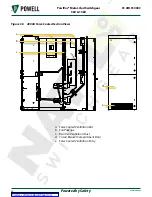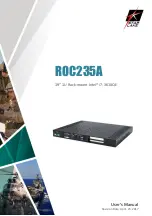
Powered by Safety
®
43
Operation
01.4IB.51000C
d. Turn the racking handle
counterclockwise until the breaker
position indicator displays
“
BREAKER TEST/DISCONNECTED
”.
e. Remove the racking handle and verify
that the manual trip operator has
returned to its normal position.
Note:
This is the Test Position.
4) Removing the Circuit Breaker from the
Test/Disconnected Position out of the Circuit
Breaker Compartment
Prior to removing the circuit breaker from the
circuit breaker compartment, make sure that
the control circuits are deenergized.
!
CAUTION
Prior to removing the circuit breaker from the
circuit breaker compartment, make sure the
circuit breaker is in the open position and all
springs are discharged.
!
CAUTION
a. Open the circuit breaker compartment
door.
b. Press down on the secondary
disconnect latch (Figure 28, d)
and remove the circuit breaker
compartment secondary disconnect
plug (Figure 28, c). Store the plug so it
will not be damaged while withdrawing
the circuit breaker.
Note:
Removing the secondary disconnect
plug will trip a closed breaker and
discharge the main closing spring.
c. Press the anti-rollout latch
(Figure 32, a) to release the circuit
breaker and pull the circuit breaker out
of the circuit breaker compartment
using the handles.
Figure 32 Anti-Rollout Latch
a. Anti-Rollout Latch
a
e. r
AckInG
p
roceDure
(e
lectrIcAl
)
This is an alternative to the manual racking
procedures described above utilizing a motor
driven mechanism and electric control,
allowing the user to perform the racking
function without being located in front of the
circuit breaker compartment. The remote
racking device mounts onto the compartment
door. Refer to the instruction bulletin provided
with the remote racking device for the proper
operational procedure.
















































